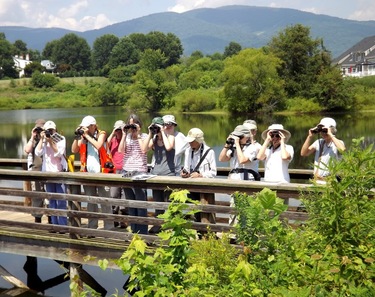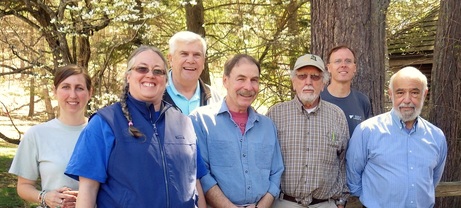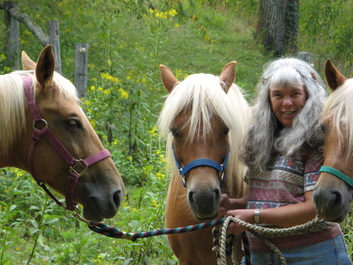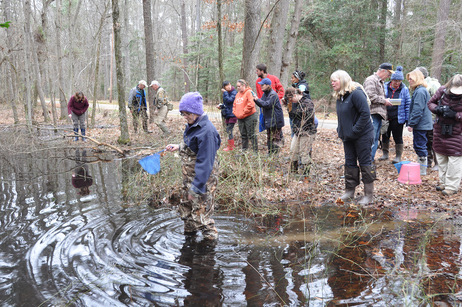Ten+ VMN Chapters Now Recruiting New Volunteers
Ten+ VMN Chapters Now Recruiting New Volunteers Read Post »
Ten+ VMN Chapters Now Recruiting New Volunteers Read Post »
 Rivanna Chapter volunteers surveying butterflies in Albemarle County. Photo by Rebecca English.
Rivanna Chapter volunteers surveying butterflies in Albemarle County. Photo by Rebecca English.
Butterfly Identification (and Counts) are Addicting!
Comparing the Data
Interestingly, three of the Chapters are along the east side of the Blue Ridge and one is in Tidewater. When comparing the data between the four chapters over the last five years (2011-2016) (or three years, 2014-2016, for the Historic Rivers Chapter,) I was excited to see what differences I would find.
First, let me explain how I had to look at this data. The butterfly counts are really a snapshot in time and place. There are many different variables within each count that are unique to each group (like weather conditions, number of hours and sites counted, level of knowledge of the participants, and geographic habitats.) These make it impossible to do a straight comparison, beyond species present/absence. Relative numbers in the end showed no real correlation between groups, only within each group, due to all the variables just mentioned. Also, because skipper identification can be difficult and the ability to accurately identify them varies so greatly between participants, I took that category out of the comparison.
So what did I find? Looking at species presence/absence between the regions, what a surprise (or not) it was to find that all four regions had most of the same species! This was despite the huge variabilities that each had. All four regions had large quantities of ‘the Big Three’: Eastern Tiger Swallowtail, Cabbage Whites, and Eastern Tailed Blues, (plus one, the Silvery Checkerspot, if you don’t count the HRMN region where they don’t appear.) No surprise there, either. And kudos to the ORMN – they had the state record for the most Eastern Tiger Swallowtails seen on a count – 2375, in 2013!! Many years they have seen over 600, but that year was outstanding!
While 2010 predated the start of the other three counts, that year had an exponential increase in the number of individual butterflies for the CBRMN count – over four times the usual average total amount. And in particular, those Big Three plus One species. Why 2010? We may never know without a broader data base and climate variabilities of what was happening in Virginia that year.
Susan McSwain (CBRMN) remembers 2010 with fondness as the “Red-spotted Purple Year.”
“As the leader of the Nelson Count, every year I keep hoping for another “Red-spotted Purple Year!” In 2010, we counted 136 Purples, with a whopping 129 of them being on a single segment of the County route. By car and foot, we traversed a three mile gravel road, with lovely Purples around every bend. These butterflies are truly accommodating to counters. They sit still on the ground, wings outstretched, ever so often lazily closing their wings above their back. With brilliant colors on both sides of their wings, they are eye candy. Except for 2010, during the 17 years of the Count, the average number of Purples seen on County Day has been eight. This year, 2016, we did not see a single Purple. Maybe 2017 will be another grand year for Purples! I can always hope!”
|
Common Name
|
Not seen by which Chapter
|
Comments
|
Glassberg agrees it shouldn’t be seen there
|
|
Black Swallowtail
|
Central Blue Ridge
|
Last seen in 2008 (one)
|
|
|
Zebra Swallowtail
|
Central Blue Ridge
|
Last seen in 2011 (one)
|
|
|
Harvester
|
Old Rag, Historic Rivers
|
|
|
|
Little Yellow Sulphur
|
Historic Rivers
|
Yet seen at Chippokes State Park across the river
|
|
|
Juniper Hairstreak
|
Rivanna
|
No red cedar stands?
|
|
|
Great Spangled Fritillary
|
Historic Rivers
|
|
Agrees – too far south
|
|
Meadow Fritillary
|
Historic Rivers, Rivanna, Central Blue Ridge
|
|
Agrees – in northern latitudes and higher elevations which Old Rad Chapter is in
|
|
Silvery Checkerspot
|
Historic Rivers
|
|
Agrees – too far southeast
|
|
Tawny Emperor
|
Rivanna, Historic Rivers
|
|
|
|
Common Name
|
Seen only by which Chapter
|
Comments
|
Glassberg agrees it should be seen there
|
|
Appalachian Brown
|
Historic Rivers
|
habitat: wet woods (marshes)
|
Agrees. But why not our other regions? No wet woods?
|
|
Gemmed Satyr
|
Historic Rivers
|
|
Agrees – in the south only
|
|
American Copper
|
Old Rag
|
|
Agrees – more north/mountains by this time of year
|
Reference: Glassberg, Jeffrey. Butterflies through Binoculars: The East. New York: Oxford University Press, 1999.
Butterfly Data Comparisons from Around the State: Surprising….or Not? Read Post »
 A few of the very dedicated volunteers of the Alleghany Highlands Chapter!
A few of the very dedicated volunteers of the Alleghany Highlands Chapter!
 Christine Hodges, Chapter Advisor of the Year (VMN-Alleghany Highlands Chapter)
Christine Hodges, Chapter Advisor of the Year (VMN-Alleghany Highlands Chapter)
 Susan McSwain (VMN Volunteer of the Year), and her ponies.
Susan McSwain (VMN Volunteer of the Year), and her ponies.
|
Name
|
Chapter
|
Nomination Highlight
|
|
Paxton Allgyer
|
High Knob
|
“Paxton is almost always in attendance
at chapter meetings, continuing education hikes and other activities and is always taking copious notes! It’s my belief that Paxton will prove to be a backbone of the High Knob Chapter in coming years.” |
|
Marian Childress
|
Tidewater
|
While most of us are sleeping, in the spring through the fall, she wakes daily at 3:30 am and mounts an ATV to survey miles of the beaches to identify a sea turtle nesting crawl or other marine animals that may have washed ashore. Marian spends countless hours alone protecting our
environment, not because she was told too, not because she is paid too, because she has the will to look beyond herself and see the greater good of her time spent as a VA Master Naturalist. |
|
Shirley Devan
|
Historic Rivers
|
Amazingly, she has recorded over 4000 volunteer hours, with over 100 hours just in the recent month of May. She inspires and motivates by her tireless efforts, the ripples of her pebble having spread far, both within and beyond our chapter.
|
|
Barbara Dunbar
|
Historic Rivers
|
When ideas and projects are discussed, Ms. Dunbar’s first words are always, “How can I help?” or “When do you need me?” Ms. Dunbar is the proverbial Energizer Bunny, helping out at all schools where needed, convincing new schools that they need school yard habitats and engaging partners to help them.
|
|
Kathy Fell
|
S0uthwestern Piedmont
|
The VMN Southwestern Piedmont Chapter has flourished under Kathy Fell’s leadership over the past two years. Her infectious wonder of the natural world, her superlative organizational skills, her ability to inspire, her high standards of science, her friendliness and hospitality, and her amazing energy level are the reasons that I believe she deserves this recognition.
|
|
John Gilliam
|
High Knob
|
John has taught classes, led outreach efforts and served the chapter well as its president since the chapter received its charter. John is passionate about the natural world, and the High Knob Chapter would not be where it is today without his work.
|
|
Laura Greenleaf
|
Riverine
|
Laura brought together a small group of enthusiasts to propose a new, with coalition-based approach which evolved into the James River Park System Invasive Plant Task Force. Laura has acted as coordinator: recruiting members, organizing meetings, and managing communication. With Laura as leader, the Riverine chapter continues to fill a leadership role
in a stewardship and education project of growing impact and staying power. |
|
Sandy Greene
|
Headwaters
|
She has been an inspiring figure for me and several of my classmates, organizing projects and work days, and explaining the inter-workings of government agencies with whom we cooperate. She has trained us in stream monitoring, as youth educators getting kids in the stream, and as public educators manning booths at festivals and creating pollinator gardens to raise public awareness, to name a few activities.
|
|
Daina Paupe Henry
|
Peninsula
|
Ms. Henry understands the value and benefits of education for life-long learners. This made her a perfect fit to lead the Chapter Basic Training Committee for the last three cohorts. While leading the Basic Training Committee, Ms. Henry has also led two significant Chapter projects: Endview Plantation and Water Quality Monitoring.
|
|
Lee Hesler
|
Pocahontas
|
Over the last three seasons, Lee has managed the Vernal Pool Cooperative project’s membership, pool inventory, data collection and submission, and data archiving. His
organizational skills and attention to detail have been superlative. He has personallyinteracted with each of the volunteers with the project and has developed a naming schematic for the individual sites. |
|
Gordon Kellet
|
Riverine
|
Gordon represents the Virginia Master Naturalists with enthusiasm and professionalism. His dedication to the Virginia Master Naturalists and passion for conservation have allowed for continuing effectiveness of our Outreach Committee as we engage with the community at farmer’s markets, various festivals, and other educational events.
|
|
Charles Petty
|
Old Rag
|
Charles has volunteered for every Meaningful Watershed Educational Experience (MWEE) with the Culpeper Soil and Water Conservation District for at least the last 5 years – reaching over 700 students a year. I know when he runs the macroinvertebrate station the students are in great hands!
|
|
Dianna Bridges
|
New River Valley
|
Additionally, Diane’s enthusiasm brings a sense of community to the chapter. She attends a majority of the chapter events, promotes publicity, and keeps the chapter moving forward and constantly evolving. She is a consistent contributor, always reliable, and goes above and beyond normal volunteering.
|
|
Tom Teeples
|
Northern Neck
|
He has an innate curiosity for nature and often engages our members as he finds some unusual species and asks for assistance in hunting down a likely identification. Tom became instrumental in developing walking trails around his retirement community for the residents and visitors to enjoy and use as part of their health and wellness programs.
|
|
Adrie Voors
|
Headwaters
|
This year, Adrie has created a compost drop-off station at our local Harrisonburg Farmer’s Market. The project is a first-year success collecting over 3000 pounds of waste from 544 donors in the first 3 months. Though the Market Compost project may be Adrie’s favorite volunteer project, it is certainly not her only one! She just never seems to stop!
|
|
Barbara Walker
|
New River Valley
|
Barbara has worked tirelessly developing the Pollinator Gardens at Pandapas Pond in Jefferson National Forest. Despite initial frustration (deer eating everything) she has persevered. With the help of volunteers, the gardens have developed into an educational showplace visited by hundreds of people yearly.
|
|
Elisabeth Wilkins
|
Peninsula
|
Ms. Wilkins oversaw the growth of the Chapter through the processes of new project approvals, more Partner contacts (especially the Virginia Living Museum in Newport News), and the training of a new cohort group. Ms. Wilkins also led the e-Mammal and vernal pools monitoring projects for our chapter.
|
|
Bill Wilkinson
|
New River Valley
|
One of the main project Bill Wilkinson and the MWC were involved with, for the second half of 2015, was trail building and making the steps at the Roanoke River Overlook, which had the ribbon cutting ceremony in February 2016. More than 2/3s of Bill’s volunteer hours have been trail building and maintaining – the real heavy lifting!
|
 Training for Vernal Pools Cooperative project. Photo by VMN-Peninsula Chapter.
Training for Vernal Pools Cooperative project. Photo by VMN-Peninsula Chapter.
Superlative Virginia Master Naturalists Read Post »
The Blue Ridge PRISM, in conjunction with the USDA Natural Resources Conservation Service (NRCS), hereby announces the availability of Regional Conservation Partnership Program (RCPP) funding to assist landowners with the removal of invasive plants. The dollar amount available to an eligible landowner depends on many factors but could be as high as $22,000 spread over a three-year period.
Who is eligible?
Owners of nonindustrial private forestland and agricultural producers are eligible to apply for this program. The land in question must be in the 10-county area served by the Blue Ridge PRISM (Albemarle, Augusta, Clarke, Greene, Madison, Nelson, Page, Rappahannock, Rockingham, and Warren counties) and be managed by the applicant. Your local NRCS District Conservationist (see below) can walk you through other eligibility criteria that rarely apply and answer any questions you may have.
Other program details
Each landowner accepted into the RCPP program will sign a 3-year Environmental Quality Incentives Program (EQIP) contract with the NRCS. A $643,915 pool of funds has been reserved in the RCPP program solely for work on invasive plants within this 10-county area.
Each application must include treating at least one of the following 10 high priority invasive species: ailanthus (tree-of-heaven), autumn olive, Chinese privet, garlic mustard, Japanese honeysuckle, Japanese stiltgrass, kudzu, mile-a-minute vine, multiflora rose, or oriental bittersweet. Other species on the Invasive Plant Species List published by the VA Department of Conservation and Recreation’s Natural Heritage Division may also be included in the application.
How and when to apply
The current expectation is that the program will be open for applications sometime in October or November 2016. The first contracts are expected to be signed with landowners in the December to February timeframe. However, there are important steps that you can take now in order to submit an application.
First you must establish farm records with USDA’s Farm Service Agency and verify compliance with the provisions of the Agricultural Act of 2014 or “Farm Bill”. Then you will work with your local NRCS District Conservationist and possibly your local Virginia Department of Forestry Area Forester to develop a conservation plan that outlines the specific species that will be treated and where the treatment areas are on your property. If you want to have your contract signed over the winter in order to be ready to treat invasive plants when they first emerge in the Spring, then taking these steps now is important. In many cases it will be helpful to develop the conservation plan before the plants go dormant later this year. Your NRCS District Conservationist will walk you through all the required steps.
Where can you get more information?
|
Nelson, Albemarle
|
Kory Kirkland
|
Louisa Service Center
|
kory.kirkland@va.usda.gov
|
540-967-0091
x3204 |
|
Augusta
|
Charlie Ivans
|
Verona Service Center
|
charles.ivins@va.usda.gov
|
540-248-6218
x122 |
|
Greene, Madison, Rappahannock
|
Rex Rexrode
|
Culpeper Service Center
|
rex.rexrode@va.usda.gov
|
540-825-4200
x101 |
|
Rockingham, Page
|
Cory Guilliams
|
Harrisonburg Service Center
|
cory.guilliams@va.usda.gov
|
540-433-2901
x118 |
|
Warren, Clarke
|
Jeff Barr
|
Strasburg Service Center
|
jeffrey.barr@va.usda.gov
|
540-465-2424
x108 |
Invasive Species Removal Funding Available in 10 Counties Read Post »